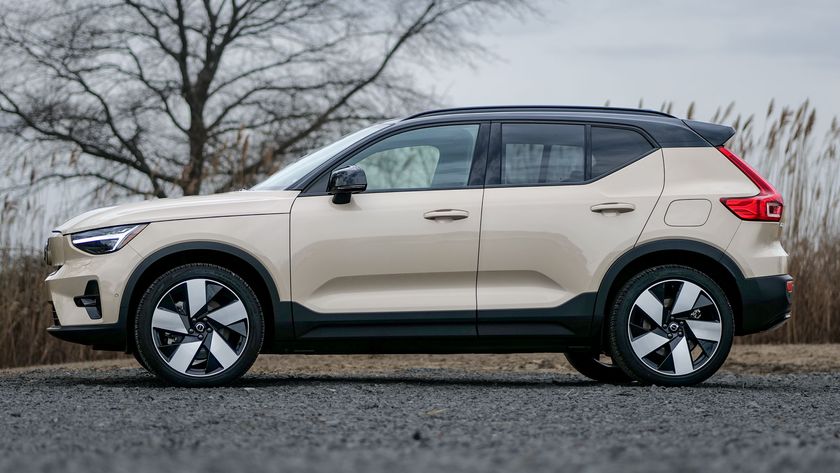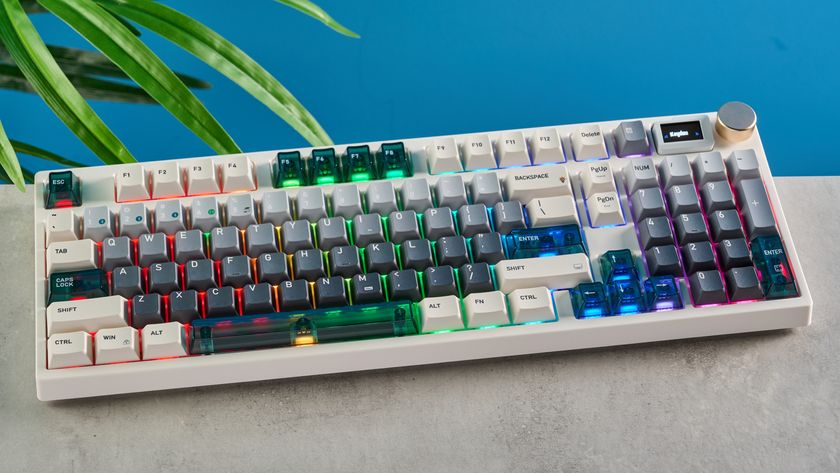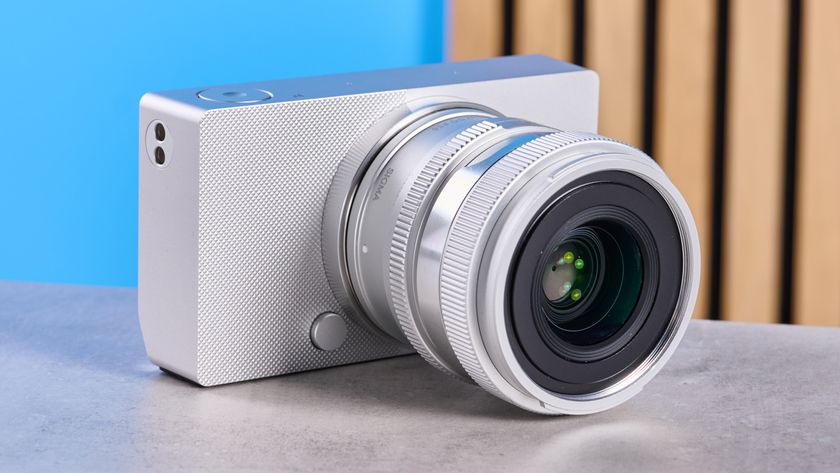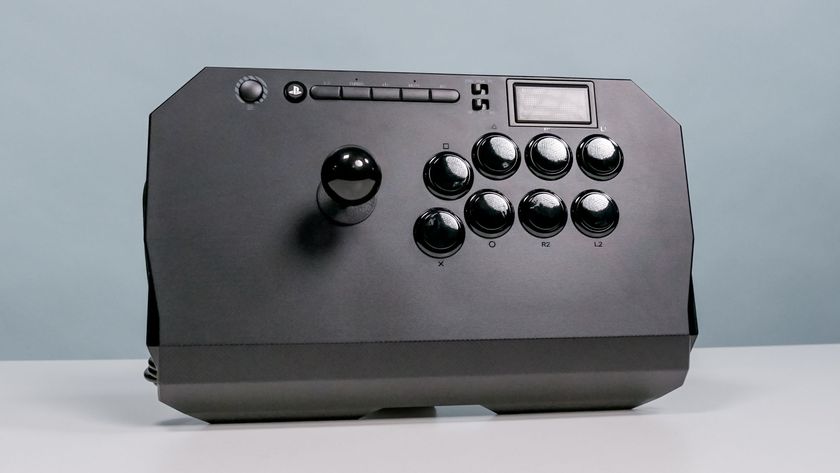Tom's Guide Verdict
The Trndlabs Skeye Nano Drone with Camera is a small, cheap and fun-to-fly drone, as long as you don't expect too much from the video.
Pros
- +
Low cost
- +
Quick to get flying
- +
Three flight modes offer levels of speed
Cons
- -
Poor video and photo quality
- -
No preview of the video
- -
No smartphone control or first-person view
- -
Controller feels awkward
Why you can trust Tom's Guide
Tiny drones are in fashion now, and the Trndlabs Skeye Nano Drone with Camera (Nano, for short) brings something new to the mix: It costs less than $70 and can record video to a microSD card. And it is definitely tiny, weighing just 0.5 ounces and measuring 2.5 inches from rotor blade tip to tip. However, like most miniature drones, it's somewhat awkward to fly, and the video quality isn't great.
Design
The Nano is clad in the company's signature orange, with a white base. Blue LEDs on the front (and red on the back) legs add to the colorful look and also indicate the status of the drone, blinking for signal loss or a low battery. An additional LED on the top of the case blinks when a photo or video is being captured from the camera, which is located on the front of the case. This camera is rather small, with the lens a tiny hole in the front.

The rotor blades are also small, each measuring just more than 1.2 inches across. The whole thing weighs very little, tipping the scales at just more than 0.5 ounces. It fits easily into the palm of the hand, with the case measuring just 1.7 inches across. It's so small and light, you won't need to register it with the FAA before flying it outside.
Specs
Rotors: Four (two blades per rotor) replaceable, 1.2-inch diameter
Battery Size: 3.7V 120-mAh Li-ion, nonremovable
Battery Life: 5/5 minutes (claimed/tested)
Flight Time: 5 minutes
Camera: 640 x 480, 30-fps video, 1-megapixel stills
Smartphone Controlled: No
FAA Registration: No
Size: 2.5 x 2.5 x 1 inch
Weight: 0.52 ounces
Controller
The Nano is controlled with a small, rather cute controller that looks more like a child's toy than a drone controller. The small size makes it somewhat awkward to hold (especially for those with bigger hands), but the two control sticks are well placed and comfortable enough to use. In addition, there is a power switch and two trim switches. The right trim switch also doubles as a trigger for video and photo: Press the right side to start/stop video or the left side to take a photo. To use it as a trim switch to adjust the offset of the control stick, you press and hold it down.

Unlike similar drones (such as the Axis Vidius), the Nano can't be controlled through a smartphone.
The Nano does, however, offer access to a trick mode. When you press down on the right stick, the drone hovers in place until you move the right stick. It then does a 360-degree flip in the direction the stick indicates. The left stick has a similar function, but pressing it in switches the drone among three flight modes: 30 percent, 60 percent and 70 percent. Each of those percentages indicates the portion of the maximum power that the drone will use; the higher the number, the faster it will turn and climb.
MORE: The Best Drones and Quadcopters on Any Budget
Flying
Small drones are often harder to fly than their bigger cousins, because the light weight means they shift very easily in the breeze. That's true of the Nano, which is a rather finicky flier. Even in the 30-percent mode, the Nano reacts quickly to movements of the stick, and is easy to send flying off in an unexpected direction if you overcompensate. Hovering requires a very light touch on the controls and good hand-eye coordination, as well as some patience. Faster maneuvers also require the same light touch to stop the drone from sliding out of control.

Keeping the drone in the 30-percent mode is definitely recommended for new fliers, as it requires a decent amount of space. The Nano is so small and light that it is unlikely to damage anyone (or anything) it bumps into, but more room allows for more time to correct a misjudged maneuver. You'll also need a decent amount of height for the trick mode, as the quadcopter loses a lot of height as it flips. If you try it from heights lower than 5 feet or so, it will probably crash.
Photos & Video
The photos and the video that the Nano captures are not great. The 640 x 480-pixel video is shot at 30 frames per second, making it look like smartphone video from five years ago. The video is noisy and soft, with even slight movement of the drone turning it into a blurry mess. The video is decent when the drone is steady, though.
The 1-megapixel photos share those problems. A slight delay between hitting the button on the remote and the drone taking the photo also makes it rather hard to judge when to take the shot.
Both photos and videos are stored on the microSD card that plugs into the side of the drone body. A 2GB microSD card, which can store more than an hour of video, is included. It worked fine with a 32GB microSD card as well, though. Also included is a USB 2 card reader that allows you to transfer the video to a PC or Mac. Although the quadcopter charges from a USB cable, it can't be used to transfer video or photos; you have to use the USB reader.
MORE: Drone Buying Guide: Everything You Need to Know
Repairability
The Nano is cheap, so it's no surprise that most of the parts are not replaceable. You can't swap out the battery or the frame, but you can easily swap the rotor blades. That's good, because they are the easiest part to break or lose, as they have a habit of popping off if the drone lands hard or flies into something. These pop straight off, and a spare set is included. Additional sets are available from Trndlabs for $9, the same price as a replacement USB charging cable. This uses a nonstandard connector on one end, so you can't just use a standard USB cable.
Battery
The battery inside the Nano is a small, 120-mAh Ni-MH model that, in our tests, provided about 5 to 6 minutes of flight time. Then, it takes about 30 minutes to recharge it from a USB port. Both of these times are pretty average for cheap miniature drones like this; the similarly sized Axis Vidius and Trndlabs Skeye both lasted about the same time in flight.
Bottom Line
Priced at $69, the Trndlabs Skeye Nano Drone with Camera is almost an impulse purchase. That's good, but you get a fairly basic drone for the price. Five minutes of flight time just flies by, and it takes a fairly long time to recharge. The $99 Axis Vidius is similar to the Nano Drone in most respects, but the latter doesn't connect to a smartphone. That means you don't get a preview of your video or the first-person viewpoint that can help you learn to fly the drone. What you do get with the Nano, however, is a lot of fun and a simple flying experience that you can record and relive later.
Richard Baguley has been working as a technology writer and journalist since 1993. As well as contributing to Tom's Guide, he writes for Cnet, T3, Wired and many other publications.














